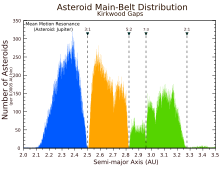| Discovery | |
|---|---|
| Discovered by | Max Wolf |
| Discovery site | Heidelberg Observatory |
| Discovery date | 9 January 1901 |
| Designations | |
| MPC designation | (467) Laura |
| Pronunciation | /ˈlɔːrə/ Italian: [ˈlaura] |
| Alternative designations | 1901 FY; 1954 OE; A924 RG |
| Orbital characteristics | |
| Epoch 31 July 2016 (JD 2457600.5) | |
| Uncertainty parameter 0 | |
| Observation arc | 115.03 yr (42015 d) |
| Aphelion | 3.26446 AU (488.356 Gm) |
| Perihelion | 2.62441 AU (392.606 Gm) |
| Semi-major axis | 2.94444 AU (440.482 Gm) |
| Eccentricity | 0.1086874 |
| Orbital period (sidereal) | 5.05 yr (1845.4 d) |
| Mean anomaly | 5.2504112° |
| Mean motion | 0° 11 42.269 / day |
| Inclination | 6.43615° |
| Longitude of ascending node | 322.48119° |
| Argument of perihelion | 91.31635° |
| Physical characteristics | |
| Dimensions | 41.96±3.2 km |
| Synodic rotation period | 36.8 h (1.53 d) |
| Geometric albedo | 0.0633±0.011 |
| Absolute magnitude (H) | 10.9 |
467 Laura (1901 FY) is Main-belt asteroid discovered on 9 January 1901 by Max Wolf at Heidelberg. The semi-major axis of the orbit of 467 Laura lies just inside the 7/3 Kirkwood gap, located at 2.95 AU. It's named after the character Laura from Amilcare Ponchielli's opera La Gioconda.


References
- Noah Webster (1884) A Practical Dictionary of the English Language
- "467 Laura (1901 FY)". JPL Small-Body Database. NASA/Jet Propulsion Laboratory. Archived from the original on 16 September 2020. Retrieved 10 May 2016.
- Scholl, Hans; Froeschlé, Claude (September 1975), "Asteroidal motion at the 5/2, 7/3 and 2/1 resonances", Astronomy and Astrophysics, 42 (3): 457–463, Bibcode:1975A&A....42..457S
External links
- 467 Laura at AstDyS-2, Asteroids—Dynamic Site
- 467 Laura at the JPL Small-Body Database

| Minor planets navigator | |
|---|---|
| Small Solar System bodies | |||||||
|---|---|---|---|---|---|---|---|
| Minor planets |
| ||||||
| Comets | |||||||
| Other | |||||||
This article about an asteroid native to the asteroid belt is a stub. You can help Misplaced Pages by expanding it. |